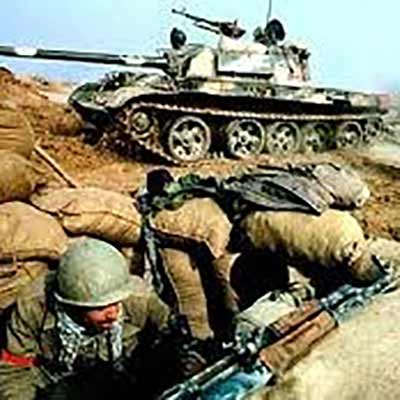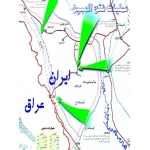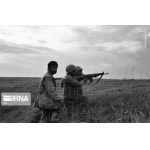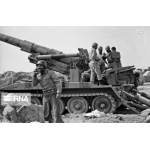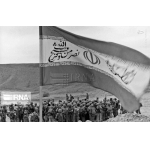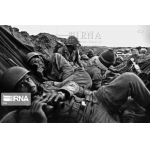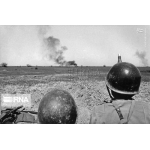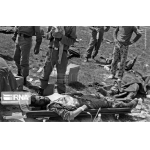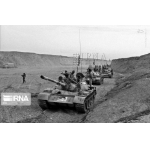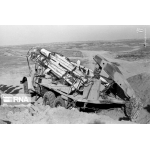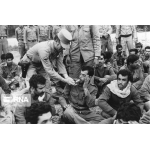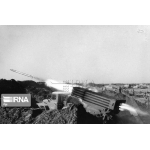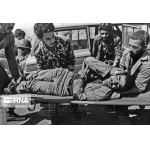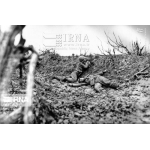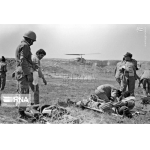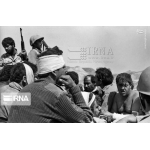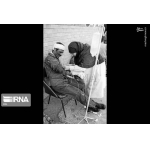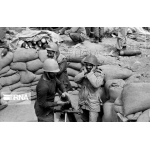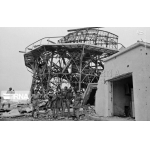Battles
Operation Fath al-Mobin
Mustafa Rahimi
342 Views
Operation Fath al-Mobin was launched on Monday, March 22, 1982, on the western side of the Karkheh River. It was conducted under the joint command of the Islamic Revolutionary Guard Corps (IRGC) and the Army and concluded successfully after seven days.
Operation Fath al-Mobin was launched in an area bordered to the north by the foothills of Kabirkouh, to the east by the Karkheh River, to the south by the Boland Mishdagh Mountains, and to the west by the Iran-Iraq border in the north and south of Fakkeh. This area had been occupied in the early days of the war. As the Joint Karbala Headquarters, Colonel Ali Sayyad Shirazi, commander of the Army Ground Forces, and Mohsen Rezaei, Commander-in-Chief of the IRGC, led the operation. In this operation, the IRGC deployed 93 infantry and armored battalions, while the Army engaged with 44 infantry, armored, and mechanized battalions against 97 infantry, armored, and mechanized battalions of the Fourth Corps of the Iraqi Army, which were supported by 12 artillery battalions and numerous Jeysh al-Shaabi forces.[1]
According to the operational plan, four divisional headquarters were supposed to conduct the operation on four different axes. In this horseshoe-shaped battlefield, Quds Headquarters was positioned in the north, Fath Headquarters in the south, Nasr Headquarters in the north and east, and Fajr Headquarters in the eastern part of the operational zone, all tasked with offensive missions. Each of these four headquarters, which were under the command of the Joint Karbala Headquarters, was led by both an IRGC and an Army commander: Aziz Jafari and Colonel Amrollah Shahbazi commanded Quds Headquarters in the Ayn Khosh axis, Hassan Baqeri and Colonel Hussain Hassani Saadi commanded Nasr Headquarters in the Karkheh Bridge axis, Majid Baqaei and Colonel Azim Azgami commanded the Fajr Headquarters in the Shush axis, and Rahim Safavi and Colonel Masoud Monfared Niaki commanded the Fath Headquarters in the Reqabiyah axis.
A few days before the operation, on March 19, 1982, some Iraqi units launched a surprise attack targeting defensive lines in the Shush and Reqabiyah axes. This unexpected assault inflicted significant losses on the military capability of Fajr and Fath Headquarters. Subsequently, the commanders at Karbala Headquarters faced a decisive dilemma: either cancel the operation or proceed with only two headquarters. Mohsen Rezaei flew to Tehran to talk to Imam Khomeini (ra) and ask for advice. He then came back to the front line and informed the commanders that Imam Khomeini (ra) believed the operation should be carried out.[2]
At 12:30 AM on March 22, 1982, Operation Fath al-Mobin began with the code-name “Ya Zahra (s)”. The Fajr and Fath Headquarters, which were temporarily excluded from engaging in the first phase of the operation, were tasked with preventing the Iraqis from deploying their troops to the northern fronts. Under the command of Hassan Baqeri from the IRGC and Colonel Hussain Hassani Saadi from the Army, the Nasr Headquarters successfully achieved all the objectives in less than half a day. They included the capturing of Qahveh-Khaneh junction, Tapeh Cheshmeh, Jofineh, Shawariyeh, and Belta Heights, as well as the Tapeh Ali-Gerehzad Hills. During the attacks on Ali-Gerehzad Hills, the main artillery units of the Iraqi Fourth Corps fell into Iranian hands.[3]
Some forces of the Quds Headquarters attacked the enemy from the west, successfully taking control of the Ayn Khosh pass and military base. However, another group encountered stiff enemy resistance in the Imamzadeh Abbas axis and was forced to retreat.[4]
The second phase of the operation began at 4 AM on March 24, 1982, with Fath Headquarters units aiming to liberate the Reqabiyeh mountains and pass. Some of these forces advanced through the Zoleyjan Pass to reach the enemy’s rear positions at Reqabiyeh, while others engaged in a frontal assault in the Reqabiyeh Plain. By 9 AM, the Iraqi resistance had been broken, and all the objectives were achieved.[5]
The third phase of the operation started at 3:25 AM on March 27, 1982, targeting the liberation of Sites 4 and 5 as well as radar facilities. Despite the commanders’ initial concerns, this phase, executed by Nasr and Fajr Headquarters, succeeded swiftly and efficiently.[6]
At that stage, the only remaining objectives of Operation Fath al-Mobin were the Abu Ghurayb Pass in the north and the Barqazeh Pass in the south. Accordingly, it was decided that Quds Headquarters and part of Nasr Headquarters’ forces would attack Abu Ghurayb, while other units under Nasr and Fath Headquarters would move south to capture Barqazeh Pass and the surrounding highlands. This final phase of the operation began on March 28th. Due to the Iraqi forces’ retreat, the objectives were secured more easily than expected. The four strategic passes of Ayn Khosh, Abu Ghurayb, Barqazeh, and Reqabiyeh came under Iranian control, and enemy forces were pushed back beyond the Doiraj River.[7]
Following the decisive victory in Operation Fath al-Mobin, 2,400 square kilometers of Iranian territory were liberated, including Ayn Khosh, Ali-Gerehzad, Tineh, Abu Ghurayb, Reqabiyeh, Dasht Abbas, and the Abu-Salibi Khat Hills. Moreover, Radar bases 4 and 5 of the Iranian Air Force were reclaimed from Iraqi occupation, and the cities of Dezful, Shush, and Andimeshk, as well as Andimeshk-Ahvaz Road, were cleared of the enemy artillery fire. In this operation, 25,000 Iraqi troops were killed or wounded,[8] and 15,000 were captured.[9] Also, 270 tanks, 150 armored personnel carriers, 6 aircraft, and 3 helicopters were destroyed.[10] Iranian forces also seized 320 tanks and armored personnel carriers, 500 vehicles, and 165 artillery pieces.[11]
[1] Doroudian, Muhammad, Jang-e Bazyabi Sobat (The War of Stability Recovery), vol. 2, Tehran: Markaz-e Motaleat va Tahqiqat-e Jang Sepah-e Pasdaran, 1378, p. 197.
[2] Alayi, Hussain, Ravand-e Jang Iran va Araq (The Process of the Iran-Iraq War), vol. 1, Tehran: Marz va Boom, 1391, Pp. 411-412.
[3] Doroudian, Muhammad, Jang-e Bazyabi Sobat (The War of Stability Recovery), vol. 2, Pp 205-206.
[4] Moein-Vaziri, Nasrullah, Negreshi Elmi be Amaliat-e Fath al-Mobin (A Scientific View of Operation Fath al-Mobin), Tehran: Sazman-e Hefz-e Aasar va Nashr-e Arzesh-ha-ye Defa-e Muqaddas Aja, 1386, Pp. 110-112.
[5] Shahan, Mohsen, Amaliat-e Fath al-Mobin, Gharar-Gah-e Fath (Operation Fath al-Mobin, Fath Headquarters), Tehran: Iran Sabz, 1387, Pp. 287-289.
[6] Dehghan, Ahmad, Nagofteha-ye Jang: Khaterat-e Sepahbed Shahid Ali Sayyad Shirazi (Untold Stories of War: Memoirs of Martyr General Ali Sayyad Shirazi), Tehran: Soreh Mehr va Nashr-e Shahid, 1381, 6th ed., Pp. 273-279.
[7] Mousavi Qavidel, Ali-Akbar, Amaliat-e Fath al-Mobin, Gharar-Gah-e Karbala (Operation Fath al-Mobin, Karbala Headquarters), Tehran: Iran Sabz, 1387, Pp. 119-120.
[8] Jafari, Mojtaba, Atlas-e Nabard-ha-ye Mandegar (Atlas of Lasting Battles), Tehran: Soreh Sabz, 1393, 35th ed., p. 74; Alayei, Hussain, Ravand-e Jang Iran va Araq (The Process of the Iran-Iraq War), vol. 1, p. 418.
[9] Darri, Hassan, Karnama-ye Nabard-ha-ye Zamini (The Record of Ground Battles), Tehran: Markaz-e Motaleat va Tahqiqat-e Jang Sepah-e Pasdaran, 1381, p. 80.
[10] Jafari, Mojtaba, Atlas-e Nabard-ha-ye Mandegar (Atlas of Lasting Battles), p. 74.
[11] Doroudian, Muhammad, Jang-e Bazyabi Sobat (The War of Stability Recovery), vol. 2, p. 209.




